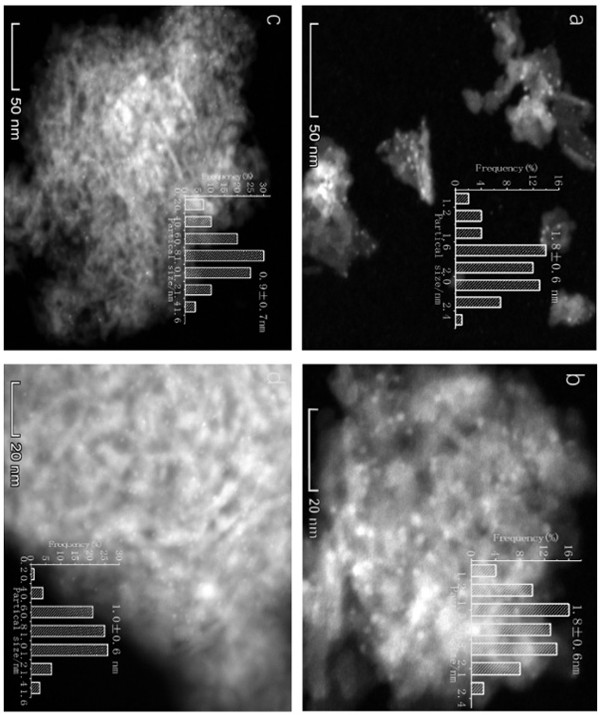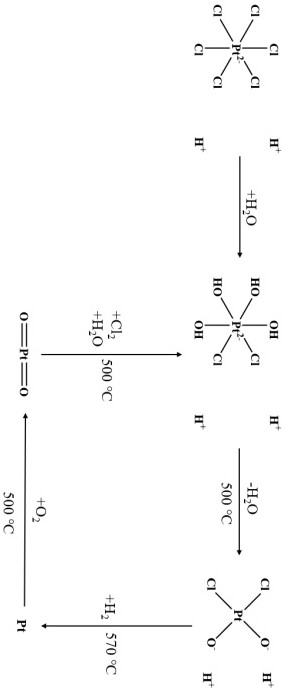Activity regeneration method for Pt-based catalyst for preparing propylene through propane dehydrogenation
A propane dehydrogenation and catalyst technology, applied in chemical instruments and methods, metal/metal oxide/metal hydroxide catalysts, physical/chemical process catalysts, etc.
- Summary
- Abstract
- Description
- Claims
- Application Information
AI Technical Summary
Problems solved by technology
Method used
Image
Examples
Embodiment 1
[0032] Fill 100 mg Pt-Sn / θ-Al in a fixed-bed tubular reactor 2 o 3 , the reactant is propane, the reaction temperature is 570°C, the reaction pressure is normal pressure, and the propane weight hourly space velocity is 7 h -1 , when the ratio of hydrogen to hydrocarbon was 1, the initial propane conversion rate was 40.5%, and the selectivity was 96.1%. After 16 h of reaction, the propane conversion rate was 28.7%, and the propane selectivity was 98.0%. The reacted catalyst was packed in a fixed-bed tubular reactor, and air was introduced to raise the temperature to 350 °C at a heating rate of 2.5 °C / min, and roasted for 30 min to remove carbon deposits, and then HCl was introduced with a volume concentration of 0.2% and a flow rate of 80 mL / min of HCl / air mixture, the temperature was raised to 360 °C at a heating rate of 2.5 °C / min, after 2 h of treatment, the introduction of HCl was stopped, and it was naturally cooled to room temperature. The treated catalyst was reduced i...
Embodiment 2
[0034] Fill 100 mg Pt-Sn / θ-Al in a fixed-bed tubular reactor 2 o 3 , the reactant is propane, the reaction temperature is 570°C, the reaction pressure is normal pressure, and the propane weight hourly space velocity is 7 h -1 , when the hydrogen-to-hydrocarbon ratio was 1, the initial propane conversion rate was 41.0%, and the selectivity was 96.5%. After 16 hours of reaction, the propane conversion rate was 29.3%, and the propane selectivity was 98.4%. The reacted catalyst was packed in a fixed-bed tubular reactor, and air was introduced to raise the temperature to 350 °C at a heating rate of 2.5 °C / min, and roasted for 30 min to remove carbon deposits, and then HCl was introduced with a volume concentration of 0.9 % and a flow rate of 80 mL / min of HCl / air mixture, the temperature was raised to 360 °C at a heating rate of 2.5 °C / min, after 2 h of treatment, the introduction of HCl was stopped, and it was naturally cooled to room temperature. The treated catalyst was reduced...
Embodiment 3
[0036] Fill 100 mg Pt-Sn / θ-Al in a fixed-bed tubular reactor 2 o 3 , the reactant is propane, the reaction temperature is 570°C, the reaction pressure is normal pressure, and the propane weight hourly space velocity is 7 h -1 , when the hydrogen-to-hydrocarbon ratio was 1, the initial propane conversion rate was 40.0%, and the selectivity was 95.9%. After 16 hours of reaction, the propane conversion rate was 30.5%, and the propane selectivity was 98.2%. The reacted catalyst was packed in a fixed-bed tubular reactor, and air was introduced to raise the temperature to 350 °C at a heating rate of 2.5 °C / min, and roasted for 30 min to remove carbon deposits, and then HCl was introduced with a volume concentration of 0.2% and a flow rate of 80 mL / min of HCl / air mixture, the temperature was raised to 400 °C at a heating rate of 2.5 °C / min, after 2 h of treatment, HCl was stopped, and it was naturally cooled to room temperature. The treated catalyst was reduced in a hydrogen atmosp...
PUM
 Login to View More
Login to View More Abstract
Description
Claims
Application Information
 Login to View More
Login to View More - R&D
- Intellectual Property
- Life Sciences
- Materials
- Tech Scout
- Unparalleled Data Quality
- Higher Quality Content
- 60% Fewer Hallucinations
Browse by: Latest US Patents, China's latest patents, Technical Efficacy Thesaurus, Application Domain, Technology Topic, Popular Technical Reports.
© 2025 PatSnap. All rights reserved.Legal|Privacy policy|Modern Slavery Act Transparency Statement|Sitemap|About US| Contact US: help@patsnap.com


